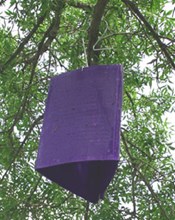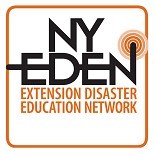Have you seen these strange purple things hanging in trees yet?
Wonder what they are?
Well, they are scent traps for an insect called the Emerald Ash Borer. They are being used in a survey to track the EAB. They are set out by the United States Department of Agriculture Animal and Plant Health Inspection Service, to track where the beetle is spreading to since its introduction into the US from China and other parts of Asia, mostly on wood crates used for shipping. Traps are generally placed in a one and a half mile by one and a half mile grid around ash trees that are within a 100-mile band of known EAB infestations. The survey detection tool is a 24-inch corrugated purple plastic prism-shaped trap that is coated with non-toxic glue on all three sides and is baited with an oil lure to attract the adult beetles.
The natural dispersal of EAB in North America is assumed to be five miles from its hatch site since adults are not strong fliers. So the rapid spread of the beetle since its North American introduction is thought to be caused by the unintentional transportation of infested ash nursery stock, firewood, unprocessed ash logs, and other ash products. In an effort to slow the continued spread of EAB, both federal and state governments have instituted various quarantines of infested area and to regulate the continued transport of ash products.
Emerald Ash Borers are a small but destructive member of the metallic wood boring beetle family. The adults feed on leaves but the larvae are laid by the females in crevices and holes in Ash trees. The larvae burrow into the wood creating ‘galleries’ that cause the damage to the tree by disrupting the normal flow of nutrients to the rest of the tree.
Larval feeding ends by autumn, at which time the fifth instar larvae overwinter in one-third inch deep pre-pupal chambers in the outer portion of the sapwood. Pupation generally takes place the following spring (late-April to May), with adults staying in the pupal chambers for one to two weeks, at which time they emerge headfirst through a distinctive one-eighth inch to one sixth inch D-shaped exit hole, beginning the cycle of life over again.
More than 40 million ash trees have died or are dying from emerald ash borer attack in the United States since the beetle’s introduction sometime shortly before its discovery in 2002. More than 7.5 billion ash trees remain at risk. In New York, Emerald Ash Borer has been found in Cattaraugus, Steuben, Ulster, Monroe, Genesee, Livingston and Greene Counties.
What can you as a tree owner do to stop the spread of this insect? Don’t transport firewood! Check the Cornell Cooperative Extension New York Invasive Species Information website for further information.
All information contained in this article is from the New York Invasive Species Information Clearinghouse and the Cornell Cooperative Extension website. Compiled by Phyllis Minich, CCEFM Master Gardener.






